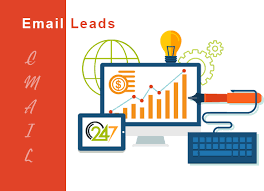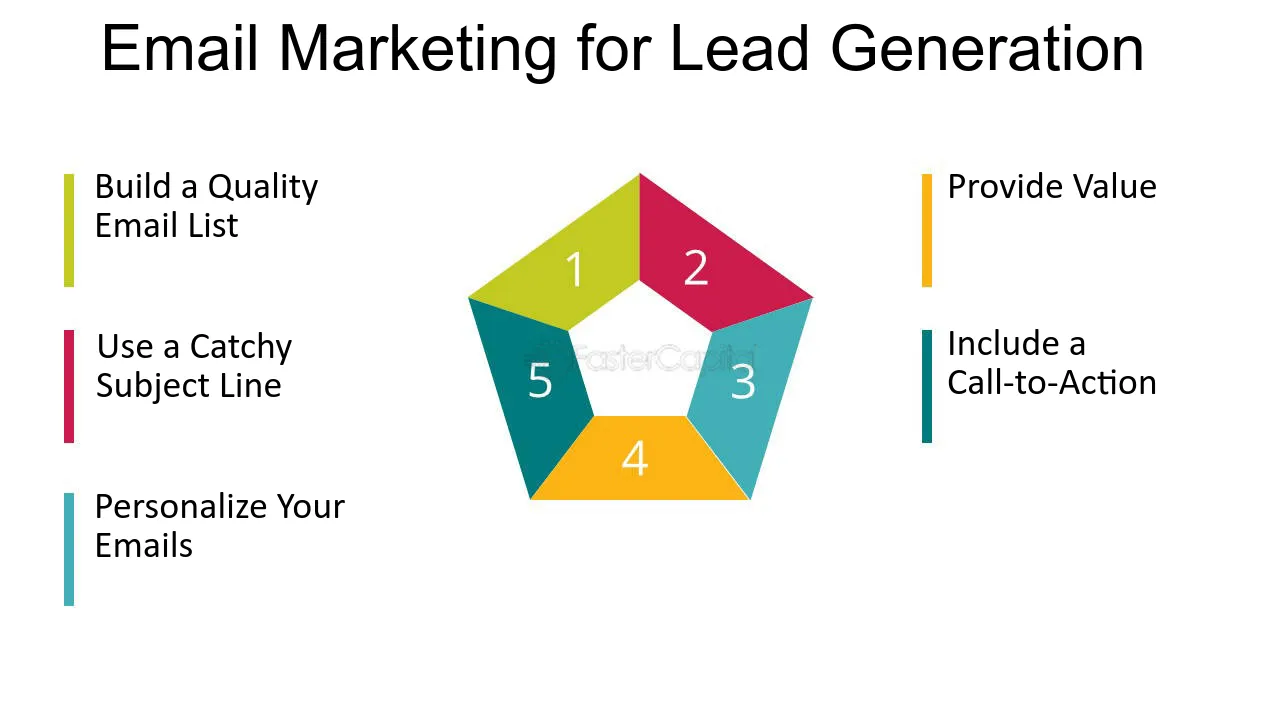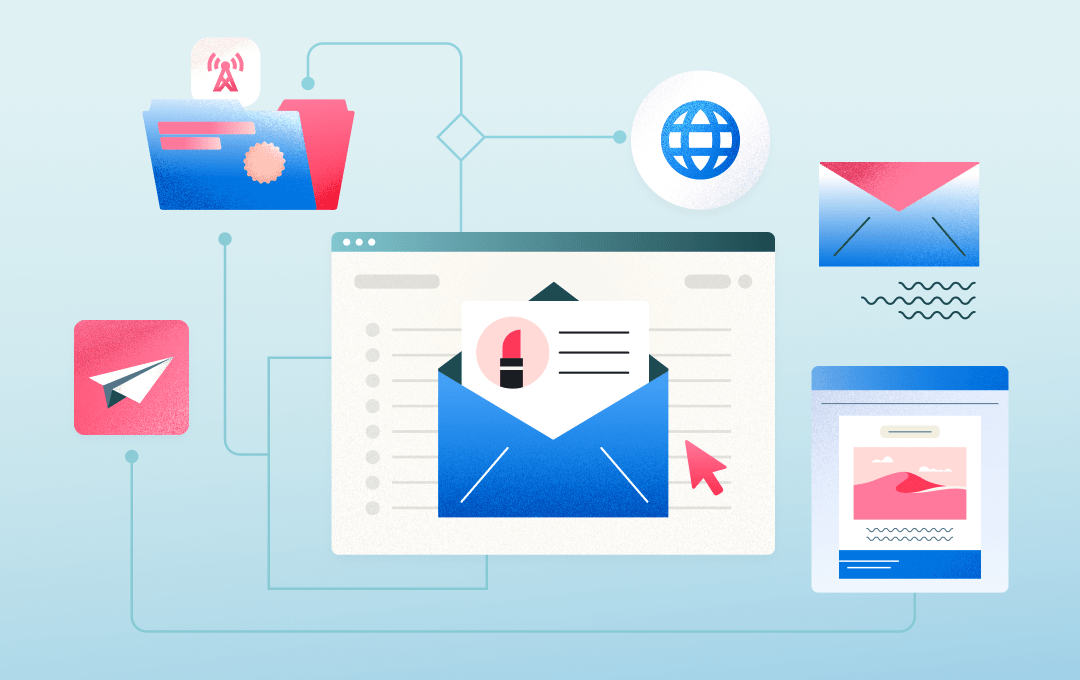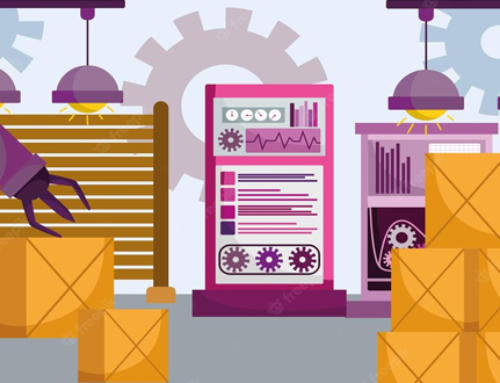Introduction to Lead Generation Through Emails: A Timeless Tool in the Digital Age
In the ever-evolving landscape of marketing, email marketing remains a powerful tool for generating leads and nurturing them into loyal customers.
The Enduring Significance of Email Marketing in Lead Generation
Despite the rise of social media and other digital marketing channels, email marketing continues to hold significant value in lead generation. Here’s why:
- Extensive reach: With billions of active email users worldwide, email offers unparalleled reach to a vast and diverse audience.
- Cost-effectiveness: Compared to other marketing channels, email marketing offers a high return on investment (ROI), making it an accessible and cost-effective way to reach your target audience.
- Measurable results: Email marketing campaigns can be tracked and analyzed in detail, allowing you to measure their effectiveness and optimize your strategies for improved results.
- Personalization potential: Email offers the ability to personalize messages based on individual preferences and behaviors, fostering stronger connections and enhancing engagement.
- Direct communication channel: Email establishes a direct communication channel with potential customers, allowing you to nurture leads, deliver targeted content, and promote your offerings.
The Evolution of Email as a Powerful Marketing Tool
Email marketing has evolved significantly from its early days of simple text-based messages. Today’s email marketing landscape embraces various advanced features and strategic approaches to maximize its effectiveness:
- Segmentation and targeting: Divide your email list into segments based on demographics, interests, or behavior, enabling you to deliver targeted messages that resonate with each segment.
- Automation: Utilize email automation tools to send triggered emails based on specific events or actions, such as welcoming new subscribers or following up with abandoned carts.
- Mobile-friendly design: Ensure your emails are optimized for mobile devices, as an increasing number of users access their email on smartphones and tablets.
- Interactive content: Employ interactive elements like polls, surveys, and quizzes within your emails to increase engagement and gather valuable customer insights.
- Personalization: Leverage data analytics and customer information to personalize email content, subject lines, and sender names, creating a more relevant and engaging experience for each recipient.
By understanding the significance and evolution of email marketing, businesses can leverage this powerful tool to effectively generate leads, nurture relationships, and drive conversions. However, simply sending emails is not enough. In the next section, we will delve into strategic approaches and best practices for crafting compelling email campaigns that captivate your audience and generate valuable leads.

Crafting Compelling Email Campaigns for Lead Generation: Capturing Attention and Driving Action
While email marketing offers a powerful platform for lead generation, the key to success lies in crafting compelling email campaigns that capture your audience’s attention and drive them to take action. This section explores the key components of successful email campaigns, including engaging copywriting, impactful visuals, and persuasive calls to action.
Writing Engaging Email Copy: From Subject Lines to Compelling Content
The first impression matters, especially in email marketing. Here’s how to craft engaging email copy that resonates with your audience:
- Captivating Subject Lines:
- Keep it concise and clear: Aim for subject lines under 50 characters to avoid getting cut off in inboxes.
- Spark curiosity and intrigue: Use strong verbs, questions, or benefits to entice recipients to open the email.
- Personalize when possible: Use the recipient’s name or other relevant information to personalize the subject line and grab their attention.
- Compelling Content Structure:
- Start with a clear value proposition: Briefly explain how your email benefits the recipient and why they should keep reading.
- Personalize the body content: Segment your audience and tailor the content to address their specific needs and interests.
- Maintain a clear and concise writing style: Use simple, easy-to-understand language and avoid jargon or technical terms.
- Incorporate storytelling and social proof: Share compelling stories, customer testimonials, or case studies to build trust and showcase the value you offer.
- Powerful Closing:
- End with a clear call to action (CTA): Tell the reader exactly what you want them to do next, whether it’s visiting a landing page, downloading an ebook, or scheduling a demo.
- Make the CTA prominent and easy to find: Use strong verbs, contrasting colors, and clear instructions to ensure the CTA stands out.
Designing Eye-Catching Visuals and Layouts: Enhancing User Experience
In today’s visually driven world, effective email design plays a critical role in enhancing user experience and increasing engagement. Here’s how to create visually appealing emails:
- Maintain a clean and professional layout: Utilize a clear hierarchy with proper spacing, headings, and bullet points for easy readability.
- Incorporate high-quality images and graphics: Use relevant visuals that complement your content and visually represent your brand identity.
- Optimize for mobile responsiveness: Ensure your email displays correctly and adapts to different screen sizes and devices.
- Maintain consistent branding: Use your brand colors, fonts, and logos throughout the email to create a cohesive and recognizable experience.
Implementing Persuasive Call-to-Actions (CTAs): Prompting Action and Conversion
The call to action (CTA) is arguably the most crucial element of your email. It’s where you convert reader engagement into concrete action. Here’s how to craft persuasive CTAs:
- Use clear and actionable language: Tell the reader exactly what you want them to do with strong verbs like “download,” “learn more,” or “get started.”
- Create a sense of urgency: Employ limited-time offers, scarcity tactics, or discount codes to encourage immediate action.
- Highlight the benefits: Briefly reiterate the value proposition associated with clicking the CTA, reminding them of the benefit they will receive.
- A/B test different CTAs: Experiment with different wording, colors, and placements to see what resonates best with your audience and drives the highest click-through rates.
By focusing on engaging copywriting, impactful visuals, and persuasive CTAs, you can craft compelling email campaigns that effectively capture attention, nurture leads, and convert them into valuable customers. In the next section, we will explore advanced strategies for optimizing your email marketing efforts and maximizing your lead generation through email.
Building and Growing Email Lists for Effective Lead Generation: Cultivating a Sustainable Audience

A robust email list is the foundation of a successful lead generation strategy through email marketing. This section explores various organic and incentivized list-building strategies, along with effective practices for managing and segmenting your email list for optimal engagement and lead nurturing.
Strategies for Organic List Building: Earning Opt-Ins with Valuable Content
Organic list building involves attracting potential customers and encouraging them to subscribe to your email list voluntarily. Here are some effective strategies:
- Offer valuable content: Create informative blog posts, white papers, ebooks, or webinars that address your target audience’s pain points and showcase your expertise.
- Utilize website signup forms: Strategically place opt-in forms on your website, such as on the homepage, blog posts, and landing pages, making it easy for visitors to subscribe.
- Leverage social media promotions: Promote your email sign-up options across your social media platforms, highlighting the benefits of subscribing and the value you offer.
- Run contests and giveaways: Organize contests or giveaways that require email signup to participate, attracting potential customers and expanding your reach.
- Partner with complementary businesses: Collaborate with businesses that share your target audience and offer cross-promotions or joint content, exposing your brand to a wider audience and gaining potential subscribers.
Utilizing Lead Magnets and Incentives: Sweetening the Deal for Subscribers
Lead magnets are valuable resources, such as ebooks, checklists, or templates, offered in exchange for an email address. They entice potential customers with immediate value and encourage them to subscribe to your list. Here’s how to utilize lead magnets effectively:
- Align your lead magnet with your audience’s needs: Offer resources that directly address your target audience’s pain points and interests, demonstrating your understanding and expertise.
- Promote your lead magnet prominently: Clearly display your lead magnet offer on your website, landing pages, and social media platforms, making it readily available and attractive to potential subscribers.
- Create a dedicated landing page: Develop a landing page specifically for your lead magnet, explaining its benefits and capturing email addresses in exchange for access.
- Track and analyze results: Monitor the performance of your lead magnet offers, such as the conversion rate and engagement level, to identify what resonates best with your audience and refine your strategy accordingly.
Managing and Segmenting Email Lists: Nurturing Relationships for Long-Term Success
Building a large email list is crucial, but it’s equally important to manage and segment your list effectively for targeted communication and improved engagement. Here’s how:
- Data hygiene and list cleaning: Regularly remove inactive subscribers, bounced emails, and invalid addresses to maintain list quality and ensure your messages reach engaged recipients.
- Segmentation: Divide your email list into smaller groups based on specific demographics, interests, behavior, or purchase history. This allows you to deliver personalized and relevant content that resonates with each segment.
- Utilize email marketing automation: Leverage automation tools to send targeted email campaigns based on individual subscriber behavior and preferences, fostering a more personalized experience.
- Track engagement metrics: Monitor key metrics like open rates, click-through rates, and unsubscribe rates to assess the effectiveness of your campaigns and identify areas for improvement.
By implementing these strategies, you can build and grow a thriving email list of engaged subscribers who are receptive to your messages. In the next section, we will delve into email marketing best practices to ensure your email campaigns deliver value, nurture relationships, and ultimately convert leads into loyal customers.
Optimizing Email Deliverability and Inbox Placement: Ensuring Your Messages Reach Their Destination
An effective email marketing strategy extends beyond crafting compelling content and building an engaged subscriber list. Ensuring your emails reach their intended recipients, by avoiding spam filters and landing in inboxes, is crucial for success. This section explores best practices for optimizing email deliverability and inbox placement.

Best Practices for Avoiding Spam Filters: Keeping Your Emails Out of the Junk Folder
Spam filters are software programs designed to identify and block unwanted emails. Here’s how to avoid getting caught in these filters:
- Obtain explicit consent: Only send emails to individuals who have explicitly opted-in to receive your communications.
- Maintain a clean sender reputation: Avoid sending emails on behalf of suspicious or fraudulent domains, as this can negatively impact your reputation and increase the chances of getting filtered.
- Avoid spam trigger words and excessive punctuation: Steer clear of excessive exclamation points, all caps formatting, and words commonly used in spam emails, as they might raise red flags.
- Maintain a consistent sending frequency: Avoid sudden spikes in email volume, as this can trigger spam filters that identify unnatural sending patterns.
- Authenticate your emails: Implement email authentication protocols like SPF, DKIM, and DMARC to verify your sender identity and build trust with email providers.
Enhancing Email Authentication and Sender Reputation: Building Trust with Inbox Providers
Email authentication plays a critical role in building trust with email providers and improving deliverability. Here’s how to enhance your authentication practices:
- Implement Sender Policy Framework (SPF): This protocol ensures that emails claiming to be from your domain are actually sent from authorized servers.
- Utilize DomainKeys Identified Mail (DKIM): DKIM adds a digital signature to your emails, allowing email providers to verify the authenticity of the sender and prevent email spoofing.
- Deploy Domain-based Message Authentication, Reporting & Conformance (DMARC): DMARC allows you to specify how email providers should handle emails that fail authentication, helping you identify potential spoofing attempts and protect your brand reputation.
Monitoring and Improving Email Deliverability: Tracking Performance and Making Adjustments
Monitoring your email deliverability metrics is essential for identifying potential issues and optimizing your campaigns for better results. Here’s how:
- Track key deliverability metrics: Monitor metrics like bounce rate, spam complaint rate, and inbox placement rates to assess the effectiveness of your delivery efforts.
- Utilize spam checker tools: Leverage online tools to analyze your emails and identify potential issues that might trigger spam filters, allowing you to make necessary adjustments before sending.
- Maintain a clean email list: Regularly remove inactive subscribers and invalid addresses to improve your sender reputation and ensure your messages reach engaged recipients.
- Analyze and adapt your strategy: Continuously monitor your results, analyze data, and adapt your email marketing strategy based on findings to improve deliverability and reach your target audience effectively.
By implementing these best practices for avoiding spam filters, enhancing email authentication, and diligently monitoring your deliverability performance, you can ensure your valuable email campaigns reach the inboxes of your target audience, fostering stronger connections, nurturing leads, and ultimately driving conversions.
Utilizing Analytics for Email Lead Generation Success: Measuring, Testing, and Optimizing for Maximum Impact

In the dynamic world of email marketing, data plays a crucial role in optimizing your lead generation efforts. This section highlights the importance of tracking and analyzing email metrics, implementing A/B testing, and integrating email analytics with CRM systems to gain valuable insights and continuously improve your email marketing strategy.
Tracking and Analyzing Email Metrics: Unlocking the Power of Data
Measuring your email marketing performance through key metrics is essential for understanding what resonates with your audience and identifying areas for improvement. Here are some crucial metrics to track:
- Delivery rate: The percentage of emails successfully delivered to recipients’ inboxes.
- Open rate: The percentage of recipients who open your email.
- Click-through rate (CTR): The percentage of recipients who click on a link within your email.
- Unsubscribe rate: The percentage of recipients who unsubscribe from your email list.
- Conversion rate: The percentage of recipients who take a desired action, such as making a purchase or downloading a resource.
By analyzing these metrics, you can:
- Identify strengths and weaknesses: Gain insights into which subject lines, content formats, and CTAs resonate best with your audience.
- Benchmark your performance: Compare your results against industry standards or internal benchmarks to track progress and identify potential areas for improvement.
- Make data-driven decisions: Use data insights to inform strategic decisions regarding email content, design, and sending frequency, optimizing your campaigns for better results.
A/B Testing for Continuous Improvement: Refining Your Approach Through Experimentation
A/B testing involves sending two different versions of an email campaign to separate groups of your email list and measuring which version performs better. This allows you to experiment and refine various elements of your email marketing strategy, such as:
- Subject lines: Test different subject lines to see which ones entice recipients to open the email.
- Content and design: Experiment with different content formats, visuals, and call-to-action placements to see what resonates best with your audience.
- Sending times and frequencies: Test different sending times and frequencies to identify the optimal timing for reaching your audience and maximizing engagement.
By continuously A/B testing and analyzing results, you can gradually improve the effectiveness of your email marketing campaigns and maximize your lead generation efforts.
Integrating Email Analytics with CRM Systems: Unifying Your Data for Deeper Insights
Integrating your email marketing platform with your CRM system allows you to centralize customer data and gain deeper insights into your lead generation efforts. This integration enables you to:
- Track individual lead engagement: Monitor how individual leads interact with your emails, such as opens, clicks, and website visits, providing valuable insights into their interests and behavior.
- Segment your audience more effectively: Leverage data from both email marketing and CRM systems to create more precise audience segments based on demographics, behavior, and engagement level, enabling you to deliver highly targeted and personalized content.
- Measure the complete customer journey: Track how leads interact with your emails and website, ultimately leading to conversions, providing a holistic view of the customer journey and the effectiveness of your marketing efforts.
By combining email marketing analytics with your CRM system, you can gain a comprehensive understanding of your lead generation efforts, identify opportunities for improvement, and optimize your overall marketing strategy for sustainable lead generation success.
Automation Strategies for Efficient Email Lead Generation

In the realm of email lead generation, deploying automation strategies can significantly enhance efficiency and effectiveness. Drip email campaigns, represented by segmenting and sending pre-written sets of messages based on predefined timelines, enable a systematic and tailored approach to engaging prospects. Personalizing automated email sequences further amplifies the impact, as it allows businesses to craft content and messaging that resonates with individual recipients. Leveraging behavioral triggers adds a dynamic element, ensuring timely responses based on user actions or preferences. This trifecta of automation—drip campaigns, personalization, and behavioral triggers—creates a seamless and responsive experience, driving engagement and conversion. As businesses embrace these strategies, they unlock the potential to nurture leads efficiently and build lasting connections with their audience.
Segmentation Techniques to Target Specific Audiences
Segmentation techniques play a pivotal role in elevating the efficacy of email lead generation. Recognizing the significance of audience segmentation is crucial, as it allows businesses to categorize their audience based on specific criteria. Effective segmentation criteria can include demographic factors, behavior patterns, or even engagement history. Once segmented, tailoring personalized content for each group becomes feasible. This personalized approach ensures that recipients receive content that aligns with their interests and needs. By implementing segmentation techniques, businesses can optimize their email campaigns, delivering targeted messages that resonate with different segments of their audience. This precision enhances the likelihood of capturing attention and converting leads into valuable opportunities.
Lead Nurturing Through Email Campaigns
Lead nurturing through email campaigns is a strategic process that involves developing a plan to foster relationships with potential leads. Crafting a lead nurturing strategy is essential, outlining how businesses intend to guide leads through the sales funnel. Sending relevant content and resources is a key component of this strategy, ensuring that recipients receive valuable information tailored to their needs and interests. Encouraging engagement and interaction is another crucial aspect, prompting leads to take desired actions and participate in meaningful interactions. Through effective lead nurturing in email campaigns, businesses can build trust, establish credibility, and ultimately enhance the likelihood of converting leads into valuable opportunities.
Interactive Content and Techniques for Engagement
Incorporating interactive elements in emails boosts engagement. Features like clickable buttons, sliders, and interactive images encourage users to actively interact with the content. Surveys, quizzes, and polls gather user participation and feedback, providing valuable insights and fostering involvement. Interactive content establishes a dialogue, facilitating meaningful interactions and stronger connections. Leveraging interactive techniques in email campaigns captures attention and drives higher levels of interaction and response.
Conclusion
In the realm of digital marketing, email remains a powerful tool for generating leads and converting opportunities. Through strategic planning, targeted messaging, and leveraging advanced techniques, businesses can maximize the potential of email campaigns to drive growth and success.
First and foremost, it’s essential to recognize the pivotal role that email plays in the lead generation process. By harnessing the reach and accessibility of email, businesses can establish direct lines of communication with their target audience, delivering personalized messages tailored to individual preferences and interests.
Furthermore, the implementation of automation strategies empowers businesses to streamline their email marketing efforts, ensuring timely and relevant communications without the need for constant manual intervention. Drip email campaigns, personalized sequences, and behavioral triggers enable businesses to nurture leads effectively, guiding them through the sales funnel with precision and efficiency.
Segmentation techniques further enhance the effectiveness of email campaigns by allowing businesses to target specific audience segments with tailored content and offers. By understanding the unique needs and preferences of different segments, businesses can deliver messages that resonate more deeply with recipients, driving higher engagement and conversion rates.
Additionally, the integration of interactive content and engagement techniques adds another layer of effectiveness to email marketing initiatives. By incorporating elements like surveys, quizzes, and interactive features, businesses can foster greater interaction and participation among recipients, strengthening relationships and driving meaningful interactions.
In conclusion, the strategic use of email marketing to generate leads and opportunities offers immense potential for businesses seeking to expand their reach, engage their audience, and drive growth. By embracing innovation, personalization, and engagement, businesses can unlock the full power of email as a lead generation tool, driving tangible results and maximizing ROI.









